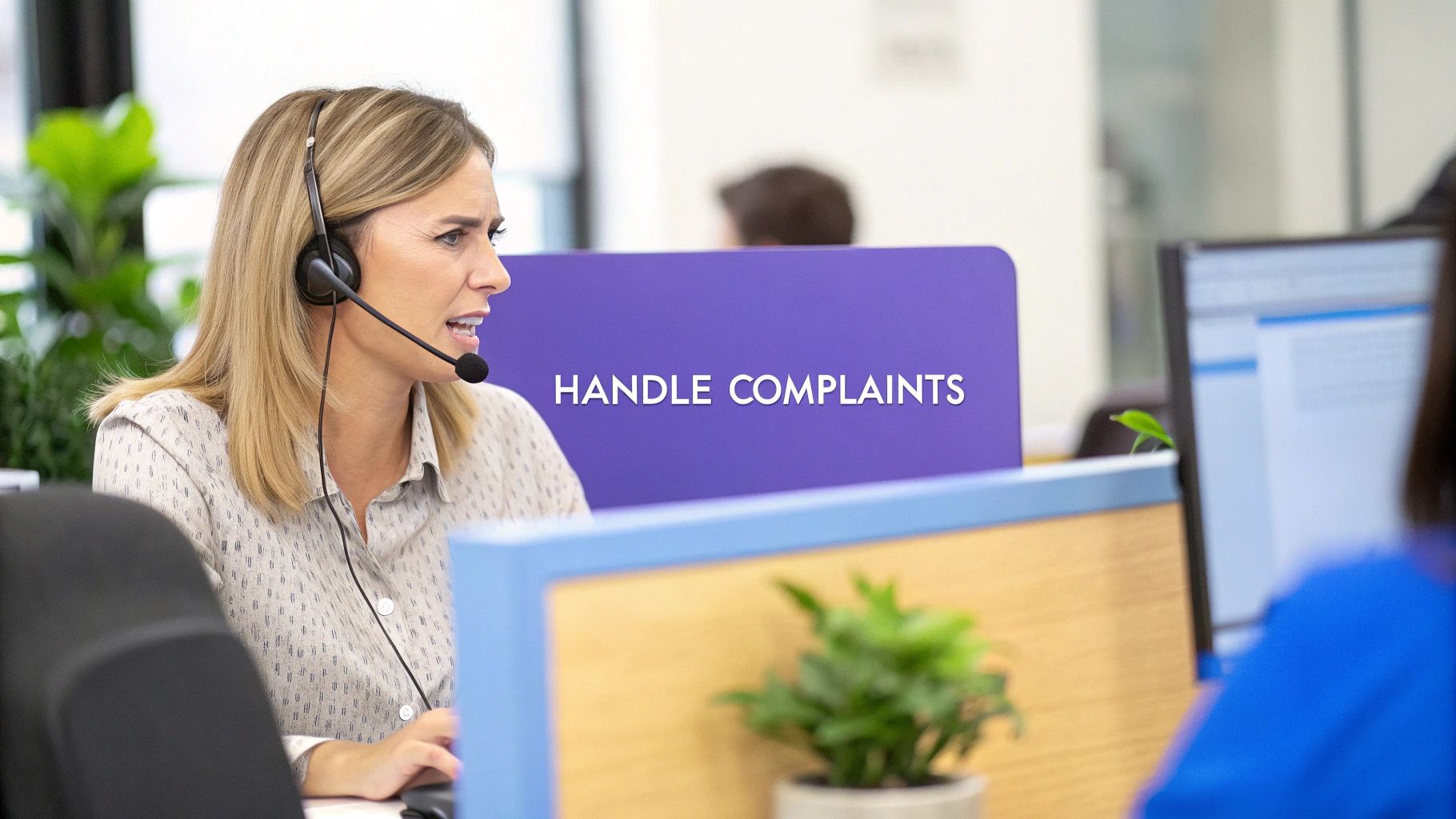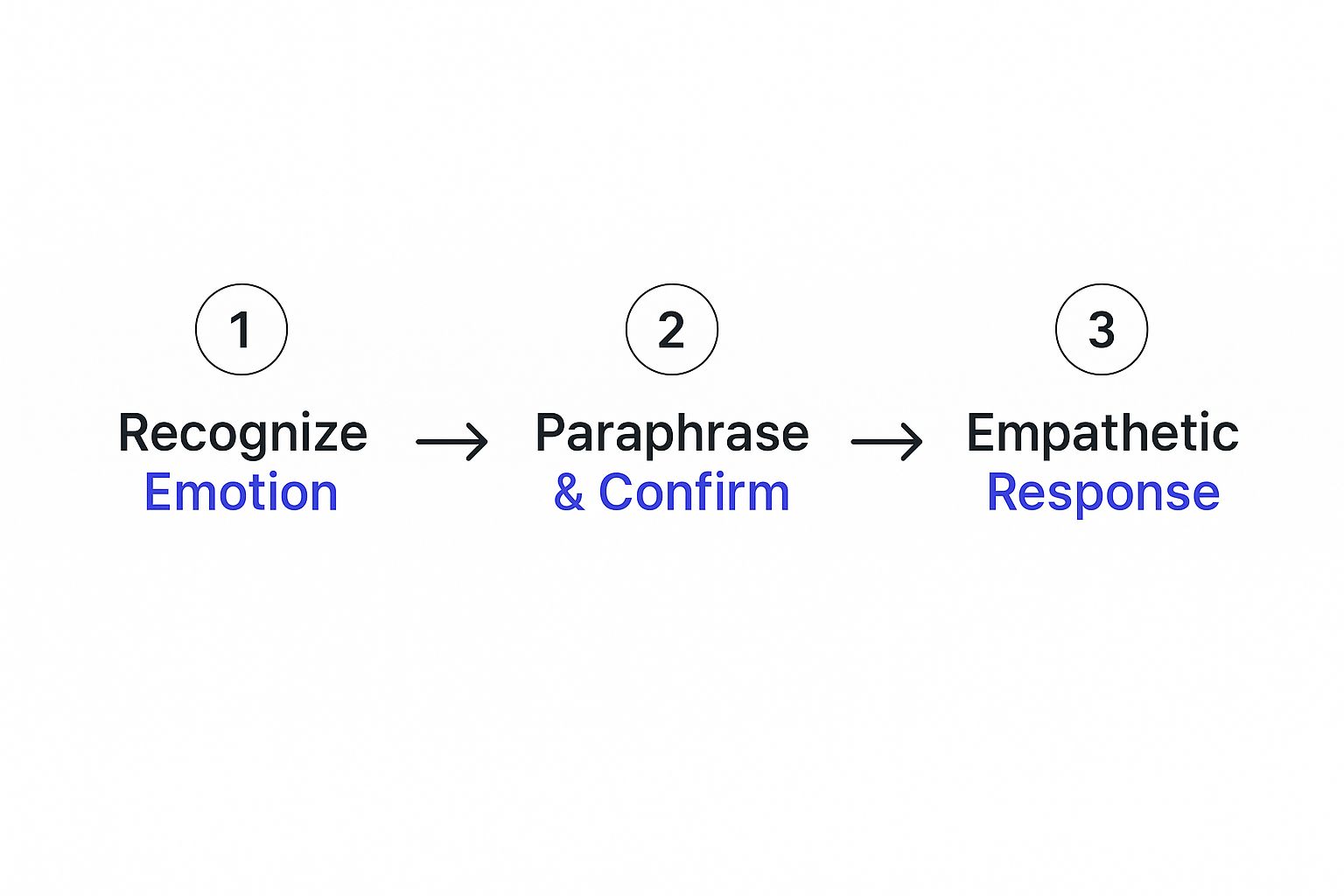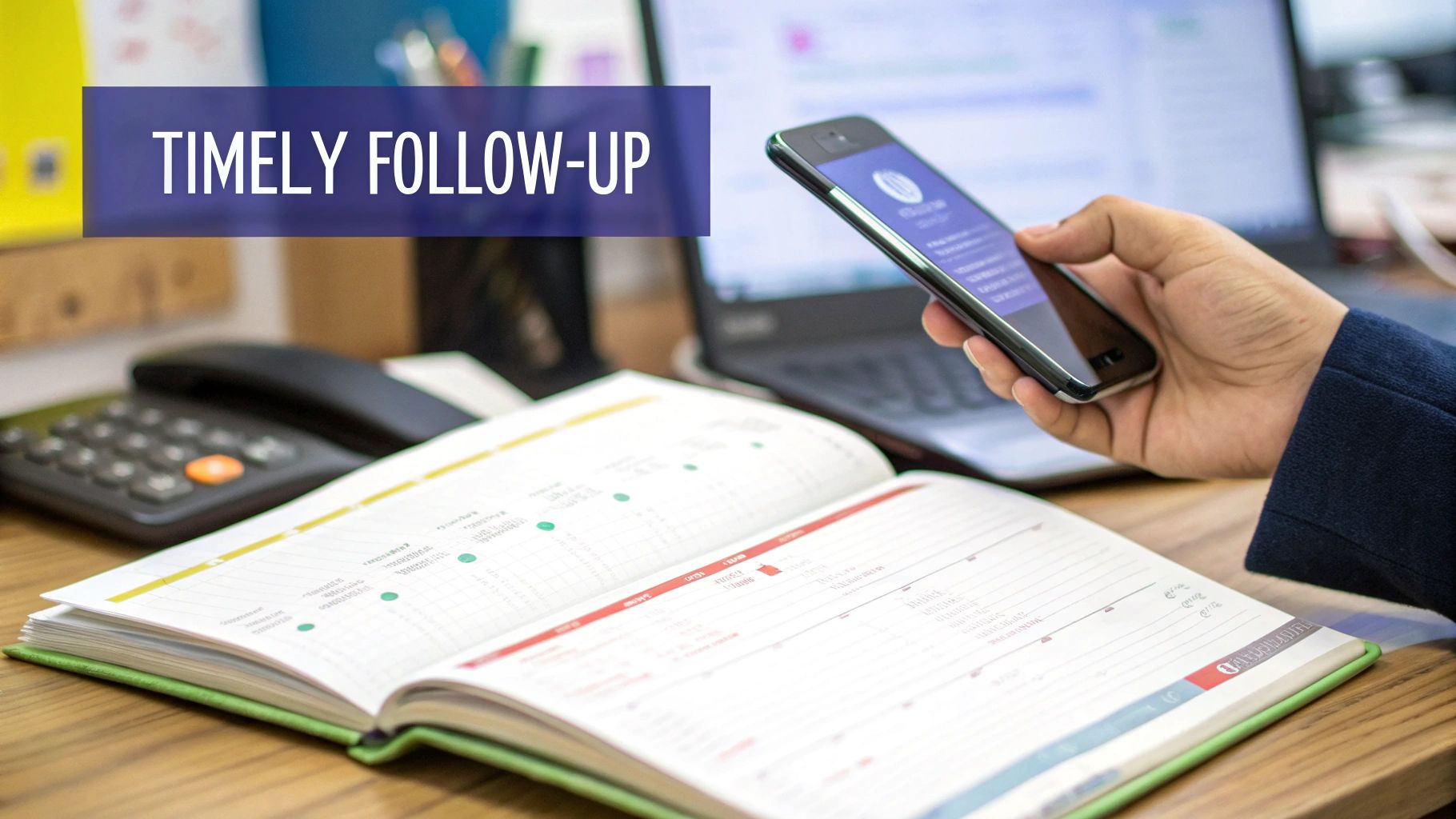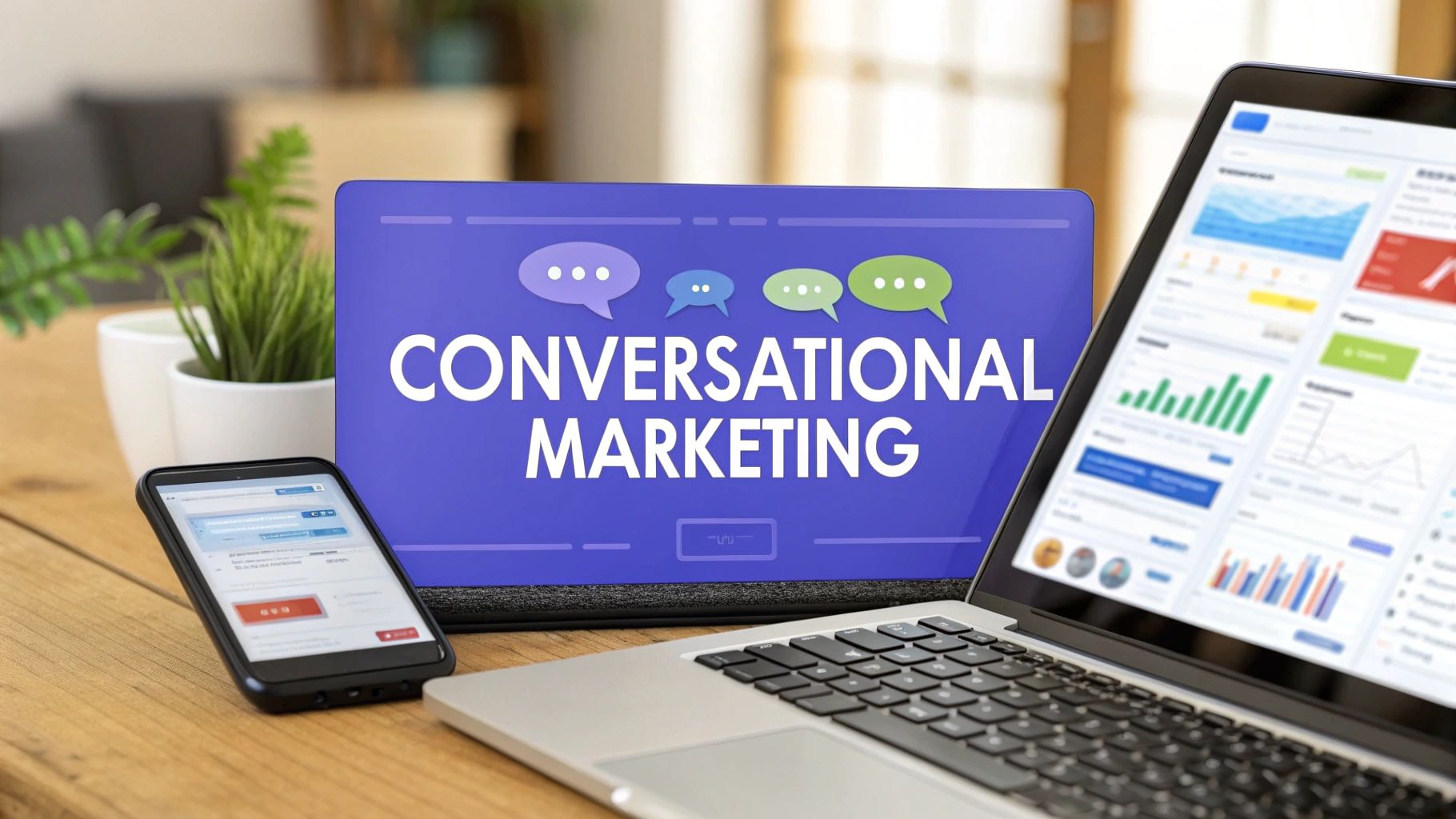How to Handle Client Complaints Effectively
Learn how to handle client complaints with proven strategies that turn unhappy customers into loyal advocates. This guide offers actionable advice.

When a client complains, that moment is a crossroads. Your next move determines whether you strengthen the relationship or lose that customer forever. The right approach involves active listening, genuine empathy, and quick, decisive action. It is about more than just fixing a problem; it is about showing the client you value their business.
Why a Solid Complaint Handling Process Matters

Think of a complaint not as a failure, but as an important moment of truth. A single bad experience is often all it takes to send someone searching for a competitor. The stakes are high.
In fact, research shows that 57% of customers will jump ship to a competitor after just one negative interaction. That number drives home just how important it is to get your response right the first time. It highlights the real cost of subpar service and makes a strong case for having a structured, repeatable process in place.
Turning Problems into Opportunities
A well-defined complaint handling process is more than just damage control. It is a framework for turning a negative situation into a positive one. Instead of viewing complaints as headaches, see them for what they are: free, direct feedback on how to make your business better.
A systematic approach makes sure every issue gets heard, logged, and addressed consistently. Nothing falls through the cracks. More importantly, it shows clients you take their concerns seriously, which is the foundation of long-term trust and loyalty.
A complaint is a gift. A customer is telling you exactly where your business can improve. When you resolve their issue effectively, you're not just fixing a problem; you're creating a brand advocate.
The Benefits of a Structured System
When you have a clear plan for handling complaints, it directly affects your bottom line and makes your team more efficient. Here is what a good system brings to the table:
- Builds Client Trust: A transparent and fair process shows clients you value their feedback and are committed to making things right. It proves you're listening.
- Provides Actionable Insights: By tracking complaints, you can spot recurring problems in your services or products and fix the root cause. For more on this, check out these best practices for your help desk.
- Reduces Customer Churn: Solving a problem effectively can turn an unhappy client into one of your most dedicated supporters. To build on that, it's worth the time to master your call handling procedure and strengthen every customer touchpoint.
Your Blueprint for the First Response
When a client complains, those first few minutes are everything. Your immediate reaction sets the stage for the entire resolution process. Get this initial response right, and you can de-escalate tension and show the client they're being taken seriously from the get-go.
The heart of a great first response is making the client feel heard. Often, their frustration is not just about the problem itself. It is the feeling that nobody is listening. Your job is to change that, whether you're on a call, in a live chat, or writing an email.
Acknowledge and Validate Immediately
Kick things off by acknowledging their frustration and validating their feelings. Simple phrases like, "I can see why that would be frustrating," or "Thank you for bringing this to my attention," go a surprisingly long way. This is not about admitting fault; it is about recognizing their emotional state and showing you respect their experience.
You don't need to have a solution right away. The priority is to establish a connection and prove that you're an ally.
This helpful infographic breaks down the core flow of an effective, empathetic response.

As the visual shows, recognizing the client's emotion is the first domino to fall. It allows you to accurately confirm the issue and respond with genuine empathy.
Master Active Listening and Paraphrasing
Active listening is about focusing completely on what the client is saying, not just waiting for your turn to talk. After they've laid out the issue, take a moment and paraphrase it back to them.
For example, you could say: "So, just to make sure I've got this right, the report you downloaded was missing the data from last quarter, which caused a delay for your team meeting. Is that correct?"
This simple act does two important things:
- It confirms you know the specific details of the problem.
- It proves to the client you were actually paying attention.
Your initial goal is not to solve the problem, but to know it. A client who feels understood is far more likely to be patient as you work to find a resolution.
This is also the perfect time to set expectations. If you don't have an immediate answer, be honest. A little transparency here builds a lot of trust. Try something like, "I need to look into this with my technical team. I will get back to you with an update within the next two hours."
First Response Dos and Don'ts
Knowing how to handle client complaints often comes down to clear, simple guidelines. For teams that need quick answers in the moment, having pre-written but customizable replies can be a huge help. You can learn more about crafting effective replies by reviewing these helpful canned response examples for customer service.
To keep your team on track during that first interaction, here is a quick reference guide.
It's a straightforward cheat sheet to reinforce good habits and avoid common pitfalls that can make a bad situation worse.
Making it easy for customers to reach a human is another key part of this first response. A 2019 report revealed that 27% of U.S. consumers get frustrated by the difficulty of reaching a live agent. This highlights why a smooth handoff from any automated system to a person is so important. You can find more insights by exploring these complaint management statistics.
Investigating the Issue and Finding a Solution

Alright, you have acknowledged the client’s frustration. Now it is time to figure out exactly what happened. This part is not about assigning blame; it is a clear-eyed investigation to get to the root of the problem.
Your goal here is to gather all the facts efficiently and without making the client repeat themselves. Start by reviewing every record you have: email threads, call recordings, chat logs, and any notes in your CRM. You're trying to piece together the timeline, figure out what was promised, and pinpoint where the disconnect occurred.
Getting to the Root Cause
Simply fixing the surface-level symptom is not enough. True resolution comes from knowing why the problem happened in the first place. If you don't, you'll be dealing with the same fire again next month.
A great method for this is the “Five Whys” technique. It is a simple but surprisingly powerful way to drill down past the obvious stuff.
Let's walk through a common scenario:
- Problem: The client is angry because their project was delivered late.
- Why 1? Because the final approval was delayed.
- Why 2? Because the project manager didn't get the required sign-off.
- Why 3? Because they were waiting for information from another team member.
- Why 4? Because that team member was unaware of the deadline.
- Why 5? Because the project handoff process wasn't documented clearly.
Suddenly, the issue is not just a "late project." It is a broken internal process. Addressing that root cause is how you stop the same complaint from happening over and over again.
Crafting a Fair and Effective Solution
Once you know the root cause, you can build a solution that actually solves the problem and, just as importantly, restores the client's confidence in your business. The best resolutions feel fair and collaborative, not like you're just trying to make them go away.
When you're putting together the fix, think about these three things:
- The Immediate Fix: What can you do right now to solve their primary problem? This is your top priority. Get them unblocked first.
- Compensation: Is a discount, credit, or refund appropriate? Compensation is not always about money; it could be a service upgrade or a free month of access. The key is that it should feel proportional to the inconvenience they experienced.
- The Prevention Plan: Clearly explain the steps you are taking to make sure this does not happen to them (or anyone else) again. This shows the client you're learning from the mistake and that their feedback genuinely matters.
Remember, 45% of customers are willing to forgive a company after receiving a sincere apology, compared to just 23% who are offered compensation alone. The apology and the solution work together to rebuild trust.
Finally, give your team the power to make these decisions. Nothing is more frustrating for an upset client than hearing, "I need to get my manager's approval for that." When a support agent has to escalate for a simple fix, it just adds delay and makes the client feel less important.
Giving your frontline team the authority to resolve common issues on the spot is one of the most impactful changes you can make. It is about trusting your team and respecting your customer's time.
Communicating the Resolution and Following Up

Finding the right fix is a huge step, but the job isn't done. How you present the resolution is just as important as the solution itself. Your communication at this stage can either lock in the client’s renewed trust or undo all the hard work you have just put in.
The key is to be clear, confident, and empathetic. Ditch the jargon and overly complex explanations. Just state what went wrong, what you have done to fix it, and what you are doing to make sure it does not happen again.
Presenting the Solution Clearly
Whether you are on the phone or writing an email, your message needs to be straightforward. Start by recapping the problem to show you're on the same page, then pivot directly into the solution.
For example, a solid email template might look something like this:
Subject: An update on your recent reporting issue
Hi [Client Name],
Thanks again for your patience as we looked into the issue with your quarterly report.
We found a data syncing error on our end that caused the incorrect figures to appear. We've already corrected the error, and I've attached the updated, accurate report for you here. To prevent this from happening again, we've put a new validation check in place.
I've also applied a credit to your account for this month to apologize for the disruption this caused your team.
Please let me know if you have any other questions.
Best,
[Your Name]
This approach is direct, takes ownership, and outlines both the immediate fix and the long-term preventative measure. No excuses, just answers.
Why the Follow-Up Is Non-Negotiable
Just because the support ticket is closed does not mean the interaction is over. A follow-up a few days later is what separates good service from great service. It's the final touch that shows you genuinely care about their business and are not just trying to clear a queue of complaints.
This simple act can be the difference between a client who sticks around and one who starts looking for the exit. The financial hit from poor service is massive; U.S. companies lose an estimated $75 billion each year due to bad customer experiences, mostly from client churn.
With stats showing that 67% of customer churn is preventable if the issue is solved on the first try, the value of getting this right is crystal clear. You can learn more about the high cost of poor customer service and see why it pays to invest here.
A quick check-in does not need to be a big production. A short email a week later is often all it takes.
Here are a couple of simple scripts you can adapt:
- "Hi [Client Name], just wanted to check in and see if the solution we put in place is still working well for you."
- "Hope you're having a good week. I wanted to follow up on our conversation last week and make sure everything was all set on your end."
This proactive step confirms the resolution worked and reinforces that you see them as a long-term partner, not just a problem to be solved. It is a small investment of time that pays huge dividends in client loyalty.
Turning Complaints into Systemic Improvements
Every single complaint is a data point. While fixing the immediate problem for one client is obviously important, the real, long-term value comes from looking at the bigger picture. When you handle client complaints well, you are not just putting out fires. You are gathering the exact intelligence you need to make your entire business better.
Think about it. A single complaint might just be a one-off. But if ten clients complain about the same confusing step in your onboarding process, you do not have ten separate problems. You have one systemic issue that needs a real fix.
Creating a Complaint Tracking System
To spot these kinds of patterns, you need a system for logging and categorizing every piece of client feedback. It does not have to be some complex, expensive software. You can get started with a simple spreadsheet or even use the features already built into your CRM.
The key is consistency. For every complaint, your team should log the same core information:
- Client Details: Who made the complaint?
- Complaint Category: What was the issue about? (e.g., Billing, Product Bug, Communication)
- Root Cause: Why did it happen? (e.g., Process Gap, Software Error, User Misunderstanding)
- Resolution: How was it fixed?
- Date: When was it reported and resolved?
This simple structure is what turns a bunch of random feedback into organized, usable data. Over time, you will be able to see which categories pop up most often and pinpoint where your biggest opportunities for improvement really are.
From Data to Actionable Insights
Once you have a system for tracking everything, you can start asking much smarter questions. Are billing complaints spiking at the end of every quarter? Maybe your invoicing process needs a second look. Are new clients constantly confused about a particular feature? That's a clear sign your documentation or user interface could be clearer.
The goal is to move from a reactive "fix-it" mentality to a proactive "improve-it" culture. When you see a pattern, it's a signal to dig deeper into the underlying process or product flaw.
Let's take a real-world example. A marketing agency might notice several clients complaining about how long it takes to get their monthly campaign reports.
- The Symptom: Clients are unhappy with report delivery speed.
- The Investigation: After reviewing the logged complaints, the team finds the delay is caused by manual data entry from three different platforms. It's a huge time sink.
- The Systemic Fix: The agency invests in a tool that automates data aggregation, cutting report generation time by 75%.
This single change, prompted by analyzing complaints, saves the team hours each week and eliminates a major source of client friction for good. It is a powerful feedback loop that drives genuine, sustainable growth.
Reviewing and Acting on Feedback Regularly
Just collecting data is only half the battle. You have to build a regular cadence for actually reviewing it. Try holding monthly or quarterly meetings with key people from support, product, and operations to go over the complaint data together.
During these meetings, focus on identifying the top three recurring issues. From there, you can create a clear action plan with assigned owners and deadlines to address the root causes. For more on this part of the process, you can learn more about analyzing customer feedback to really get the most out of it.
This proactive approach makes sure that client feedback does not just get logged; it gets acted on.
Common Questions About Handling Complaints
Even with a rock-solid process, you're going to run into weird situations that need a judgment call. When you're figuring out how to handle client complaints, it's totally normal to have questions about those gray areas.
Let's look at some of the most common ones teams run into.
What Is the Most Important First Step?
Your first move is, without a doubt, the most important part of the whole interaction. Before you even start thinking about a solution, your only job is to acknowledge the client's frustration with real empathy. A fast, heartfelt response that makes them feel heard can de-escalate things immediately.
Honestly, having the perfect fix right away matters a lot less than showing you're on their side from the get-go. A simple "I can absolutely see how frustrating this must be" sets a positive tone for everything that comes next.
How Should I Train My Team for Angry Clients?
Training has to be more than just handing someone a manual. You need to focus on practical skills like active listening, empathy, and specific de-escalation techniques. Role-playing is a game-changer here. Use real, tough complaints your business has actually faced in the past to make it stick.
It is also important to give your team the power to offer solutions without waiting for a manager's sign-off. Letting them offer a small discount or a service credit gives them the confidence to resolve issues faster. For more on mastering these interactions, check out these strategies for handling difficult customers.
The "five whys" technique is a fantastic training tool. It teaches your team to dig past the surface-level issue to find the real root cause, which leads to much better, more permanent solutions.
Is It Okay to Disagree with a Client?
Yes, but you have to handle it with care. While the goal is always to find a resolution, sometimes a client's request is just unreasonable or falls way outside your policies. In those moments, you need to be firm but polite.
Start by acknowledging their perspective. This shows you've actually listened. Then, calmly explain your position, referencing your terms of service if it helps. The key is to offer an alternative if you can. It proves you're still committed to helping, even if you can't give them exactly what they asked for.
How Can We Stop the Same Complaints from Happening?
The only way to stop repeat issues is to get organized. You need a system to track and categorize every single complaint that comes in. From there, hold regular meetings with your team to review the data and hunt for patterns.
If you notice that 15 different clients have reported the same bug in the last month, you know it's not a one-off problem. It is a systemic issue with your product or process that needs to be fixed at a higher level. This is how you turn negative feedback into real, lasting improvements.
At Chatiant, we help you build AI-powered chatbots that can handle those initial client inquiries, gather the needed details, and route complex issues to the right person. This gets every complaint a fast, organized response, freeing up your team to focus on finding the perfect solution. Learn more at https://www.chatiant.com.


